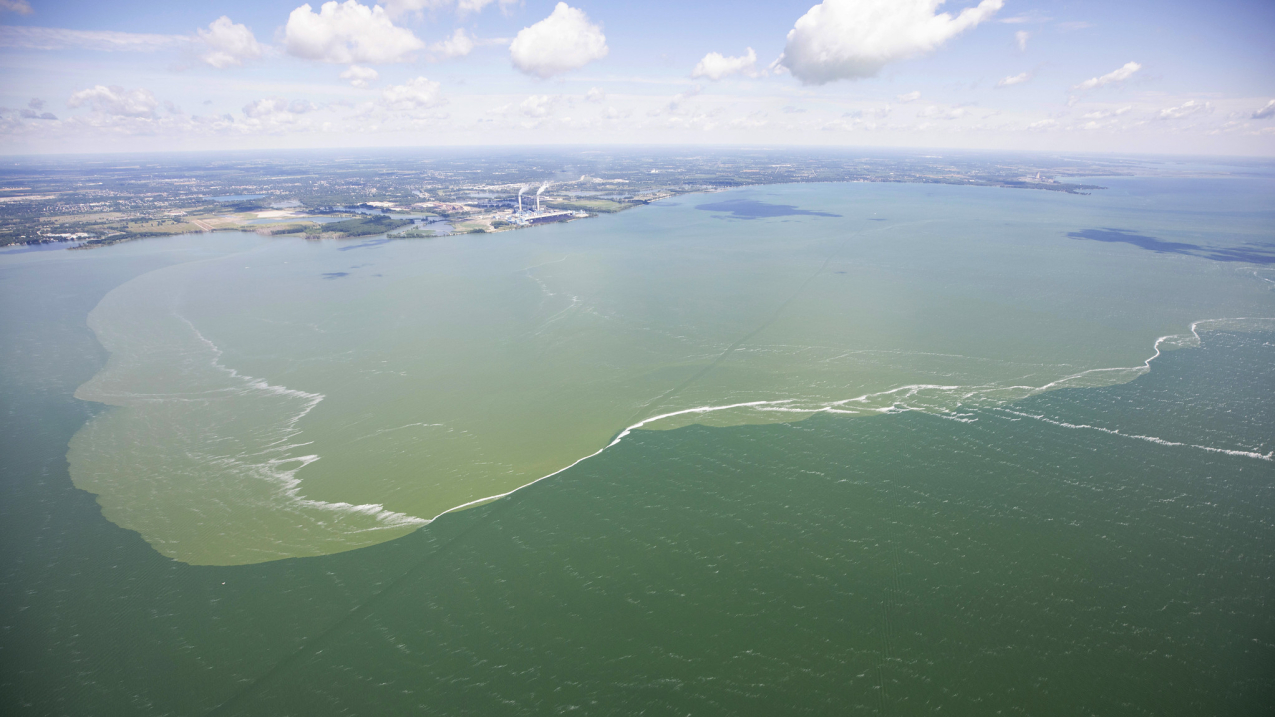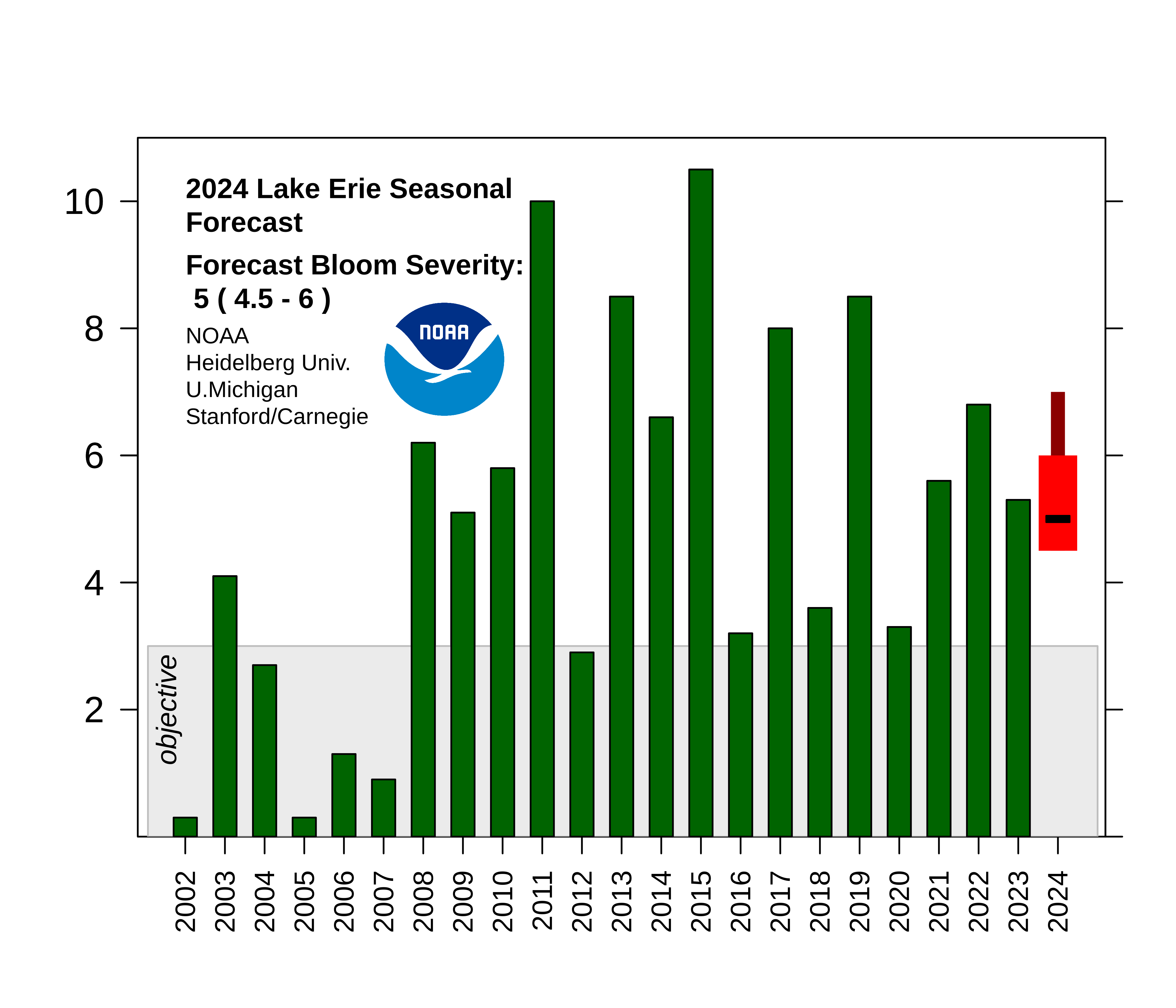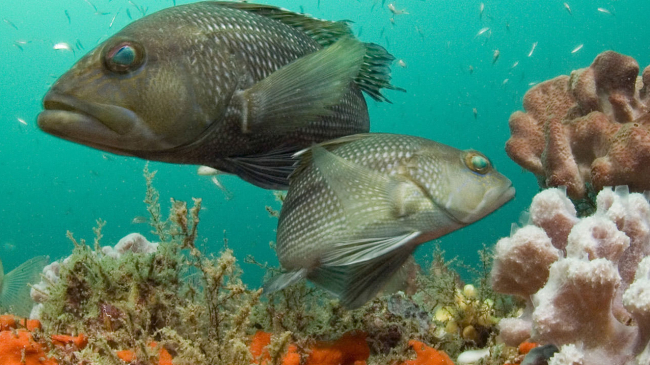Blue-green algae capable of producing substance toxic to humans and wildlife, can affect drinking water and local economies

An airborne campaign assisted in improvements to the NOAA harmful algae bloom forecast. The smokestacks are those of DTE Energy’s Monroe Power Plant in Monroe, Mich., on Lake Erie’s western shore. (Image credit: Courtesy of Aerial Associates Photography/Zachary Haslick)
NOAA and its research partners are forecasting a moderate to larger-than-moderate harmful algal bloom (HAB) in western Lake Erie this summer.
This year’s bloom is expected to measure 5, with a potential range of 4.5–6 on the severity index — similar to last year’s bloom, which had a severity index of 5.3. Moderate blooms have an index of 3–5, while an index above 5 indicates more severe HABs. Blooms over 7.5 are particularly severe, with extensive scum formation and coverage affecting the lake. The largest HABs occurred in 2011, with a severity index of 10, and 2015, with a severity index of 10.5.
The HAB severity index is based on the bloom’s biomass (the amount of algae) during the peak 30 days of the bloom.

"Understanding hazards such as harmful algal blooms helps us ensure the Great Lakes are a power in the Blue Economy," said Nicole LeBoeuf, director of NOAA's National Ocean Service. "As the science behind our forecasts improves, we can give communities better information to plan for varying blooms."
What to know about HABs
Lake Erie HABs consisting of cyanobacteria (i.e. blue-green algae) are capable of producing microcystin, a known liver toxin which poses a risk to human and wildlife health. Such blooms can force cities and local governments to treat drinking water and close beaches. HABs also harm vital local economies by preventing people from fishing, swimming, boating and visiting the shoreline.
The size of a HAB is not necessarily an indication of how toxic it is. For example, the toxins in a large bloom may not be as concentrated as in a smaller bloom. Each algal bloom is unique in terms of size, toxicity and ultimately its impact on local communities. NOAA is developing tools to detect and predict how toxic blooms will be.
NOAA’s National Centers for Coastal Ocean Science’s (NCCOS) Lake Erie HAB Forecast website provides predictions and visualizations of the bloom’s location and movement on the lake’s surface, as well as where the bloom is located within the water column. This information is especially helpful to water treatment plant operators because intake structures are usually located below the surface, so the risk of toxins in their source water may be greater when these cells sink.
“NOAA’s Lake Erie HAB forecast continues to be an important tool to help inform decisions made by drinking water treatment plants, local governments and individuals visiting Lake Erie’s shoreline and recreating on its waters,” said Christopher Winslow, Ph.D., director of Ohio Sea Grant and Stone Laboratory. “Additionally, data collected before and during each bloom season continues to inform management decisions related to nutrient management and bloom response.”
NOAA’s Lake Erie HAB forecast in detail
NOAA expects the start of a visible bloom by early July. The duration of the bloom depends on the frequency of high winds in September, which can’t be predicted this far in advance. Most of the bloom will remain in areas of the lake’s western basin. The central and eastern basins of the lake are usually unaffected until later in the season, although localized blooms may occur around some of the rivers after summer rainstorms.
The range in forecasted severity reflects the uncertainty in forecasting precipitation, particularly for July. There is a small risk of a significant rainfall event over the next few weeks; if that occurs the increased river flow and nutrient load may lead to bloom severity near the top of the forecasted range. NOAA will issue a seasonal forecast update in late July based on observed nutrient loads in the western basin watershed.
“The blooms in Lake Erie are changing. They are developing earlier over the past 10 years than previously, for reasons we do not yet understand,” said Richard Stumpf, Ph.D., NCCOS lead scientist for the seasonal Lake Erie bloom forecast. “An early start does not necessarily lead to a larger bloom, but it does mean the bloom lasts longer.”
To account for these changes, NOAA has updated the forecast model algorithms. For the last 10 years, the models used data from 2003–12 to inform Lake Erie HAB forecasts. This summer, those models are using data from 2013 to present, thereby improving the prediction of overall bloom severity.
In addition to the early season projections, much like a 5-day weather forecast, NOAA also issues HAB forecasts during the bloom season. These forecasts provide the current extent and 5-day outlooks of where the bloom will travel and what blue-green algae concentrations are likely to be seen, allowing local authorities to make informed management decisions. NCCOS also routinely delivers a hypoxia forecast for Lake Erie’s central basin.
Nutrient load data for the forecasts came from Heidelberg University in Ohio, and the various forecast models are run by NCCOS, the University of Michigan, North Carolina State University, Stanford University and the Carnegie Institution for Science. Field observations used for monitoring and modeling are done in partnership with a number of NOAA services, including its Ohio River Forecast Center, NCCOS, Great Lakes Environmental Research Laboratory and Cooperative Institute for Great Lakes Research offsite link, as well as Ohio Sea Grant offsite link, The Ohio State University’s Stone Laboratory, The University of Toledo and Ohio Environmental Protection Agency.
Climate, weather, and water affect all life on our ocean planet. NOAA’s mission is to understand and predict our changing environment, from the deep sea to outer space, and to manage and conserve America’s coastal and marine resources.
Media contacts
Douglas E. Jessmer, NOAA, douglas.jessmer@noaa.gov, (727) 282-5493
Jill Jentes, The Ohio State University, jentes.1@osu.edu, (614) 937-0072




